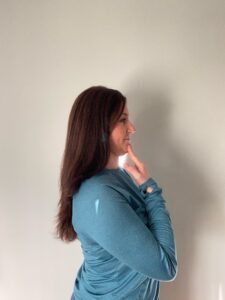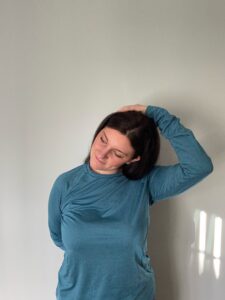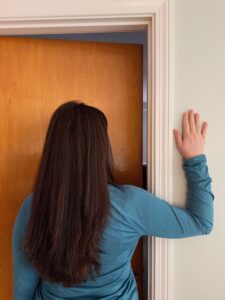Here are 5 simple postural exercises that strengthen and stretch the muscles needed for proper posture!
Chin Tucks


Gently pull your chin down and in towards your neck. Hold for 5-10 seconds, then release. Repeat 10 times. You should feel the muscles in the front of your neck engaging, but the ones on the side of your neck (the scalenes and sternocleidomastoid) should feel relaxed. You should also feel a gentle stretch at the base of your skull and back side of your neck. This exercise should not be painful and can be done 3-4 times throughout the day, whenever you need to correct your posture. If holding for 5-10 seconds is too much, you can perform controlled and slow reps without holding to start.
Scapular Squeezes


Sitting or standing, squeeze your shoulder blades down and in towards each other. Hold for 5-10 seconds, then release. Repeat 10 times. Be mindful not to engage your upper traps (do so by avoiding shrugging your shoulders upwards during this exercise). Remember not to slouch. This exercise can be done 2-3 times throughout the day, but listen to your body and rest as needed since this may be working muscles you have not strengthened in a while.
Levator Scapulae Stretch


The levator scapulae muscle runs from the transverse processes of C1-C4 vertebrae (the lateral part of the bones in your cervical spine) all the way to the medial border of of your scapula. To stretch the right levator scapulae, first put your right arm behind your back to stabilize. Then, rotate your head to the left and tilt your head down as if you are looking down at your left armpit or left front pant pocket. To intensify the stretch you can use your left arm, as shown above in the second picture, to guide your head further down – remember to direct the force of your pull in the direction of your left armpit or pocket. Start with the first picture and progress to the second one as able. A stretch should always be strong but comfortable – never painful! Hold for 30 seconds, repeat 3 times on each side. You can perform this stretch 2-3 times a day, whenever your neck is feeling stiff.
Upper Trapezius Stretch

The upper trapezius has multiple sites of attachment. It originates at the base of the skull (occipital bone), ligament nuchae, and the spinous processes of the thoracic vertebrae and inserts on clavicle (collar bone) and scapula (at the scapular spine and acromion process). To stretch the right side of the upper trapezius, start by bringing your right arm either behind your back or pushing down towards the ground to stabilize. Then, tilt your head to left (bringing your left ear to your left shoulder). To intensify, use your left hand to increase the pull towards your left shoulder and slightly forward – without rounding your upper back. You should feel a strong but comfortable stretch on the right side of your neck. Hold for 30 seconds, repeat 3 times on each side. You can perform this stretch 2-3 times a day, whenever your neck is feeling stiff.
Pectoral Stretch



The pectoral muscles are made up of pectoralis major and pectoralis minor. Pectoralis major has two heads: the sternal head and the clavicular head. The sternal head originates on the sternum, costal cartilages of ribs 1-6, and the apeneurosis of the external oblique muscle. The clavicular head originates on the clavicle. Both heads insert at the bicipital groove and the deltoid tuberosity of the humerus (your upper arm). Pectoralis minor sits under major, originates on ribs 3-5, and inserts on the coracoids process of the scapula. To stretch these muscles one side at a time, find a doorway and position one arm like a football goal post shown in the first picture. Then, turn your trunk away from the arm by taking a few small steps so your toes are now pointing on a diagonal away from the doorframe. You should feel a stretch in your upper chest and upper arm region. If you want to try stretching both sides at once, put both arms up on either side of the doorframe. Assume a staggered stance with your legs and lean forward into the doorway so that you feel a stretch on both sides of your upper chest and armpits, down into your upper arms. Hold each stretch for 30 seconds, repeat 3 times. You can perform this stretch 2-3 times throughout the day, whenever you notice you are sitting with rounded shoulders. It is important not to arch your back by engaging your abdominal muscles. Additionally, if you have a history of shoulder instability or injury, it is important to consult with a physical therapist prior to avoid aggravation or injury of the shoulder joint.
References:
https://teachmeanatomy.info/upper-limb/muscles/pectoral-region/ (accessed Nov 20, 2021)
https://teachmeanatomy.info/back/muscles/superficial/ (accessed Nov 20, 2021)
Disclaimer: This article is not medical advice or meant to be used to diagnose or treat in anyway. Always consult with your healthcare providers if you are experiencing pain or changes in your health to allow for proper evaluation, assessment, and treatment. This information is for educational purposes only. In addition, you should always consult your healthcare provider before starting a new exercise, diet, nutrition, medical, fitness, or wellness program.
Have you ever considered working on your posture before?


